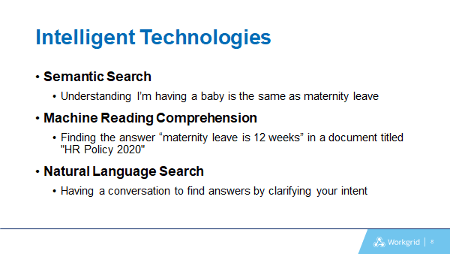Employee experience now and in the future – insights from Workgrid at the DWG Institute Technology Lab
This June we held an excellent, well-attended Technology and Research Institute Technology Lab, an online event that brought together practitioners and providers to share insights into accelerating the digital workplace. We were very pleased to be joined by a team from Workgrid, an award-winning employee experience platform, consisting of:
- Brett Caldon, CEO and Co-Founder, Workgrid
- Gillian McCann, Co-Founder and CTO, Workgrid
- Frank Pathyil, Director of Strategy and Partnerships, Workgrid.
During the Lab, the team from Workgrid led two sessions.The “Illuminate” section was about accelerating a digital workplace strategy that focuses on employee experience, while the “Innovate” session focused on the future contribution of intelligent technologies in improving search.
Putting employee experience at the heart of the digital workplace
In the “Illuminate” section, Brett Caldon explored the world of improving the employee experience in a presentation called “Accelerating your digital workplace strategy: Putting employees at the center”. This covered some of the experiences and insights the Workgid team have accumulated through helping clients to create an “intelligent employee experience”.
Brett started off the session by explaining how the employee experience really needs to be at the very heart of any digital workplace strategy and looking at some of the factors that should be considered in order to make this happen.
A key factor is getting ownership right, making sure you take a holistic approach to employee experience. Brett pointed out that multiple functions, such as HR, IT, Comms, Procurement and Support, will own different systems that make up aspects of employee experience. However, employees don’t care which system a transaction happens in, they just care about the experience and getting things done.

Making sure that you take a cross-functional and consensus view of the experience that involves the views of different stakeholders and support function is key, helping to override any concerns over different system ownership; this is about thinking holistically.
Understanding employees
Next, Brett explored the importance of understanding employees. Without a deep understanding of how employees work and think, you cannot implement a strong digital employee experience. Brett suggested three practical steps towards achieving this:
- Create employee personas to get inside the skin of a diverse workforce and design the personalized and relevant experiences employees want and need.
- Map employee journeys to understand “how employees think and feel during every single touchpoint of their journey through the company”, right from recruitment through to offboarding.
- Conduct the necessary user studies, thinking broadly and asking the right questions to successfully map employee journeys
Delivering the right digital workplace
Finally, Brett talked about delivery. How do you actually architect for digital workplace success and prepare for implementation? Here, Brett emphasized the importance of several different approaches.
The first was to adopt an iterative approach to delivery, taking small steps, always involving employees, capturing feedback at each of these steps, and prioritizing high-impact use cases. As Brett reminded us, there is “no need to boil the ocean”.

Brett then explored the concept of the “digital experience layer”, which provides a common experience, driving interfaces, alerts, forms, approvals, tasks and reminders across the plethora of different apps and systems employees use every day. Brett suggested that this approach means you can “have your cake and eat it too”, ensuring your employees can use great systems but also have a good experience. This is a principle upon which the Workgrid platform is based, drawing upon a microservices architecture and driving forward one common experience.
When actually designing the platform, two approaches are key:
- taking an outcome-driven approach to design, which focuses on a good outcome and also the end-to-end process
- getting the foundations right so that you achieve a sustainable platform that is future-proofed to preserve the employee experience, for example ensuring it is open and extensible, suitably flexible and supports a multi-channel experience.
The future of search
In the “Innovate” session, Gillian McCann and Frank Pathyil from Workgrid led a discussion on another fascinating aspect of the future employee experience – search and findability. The title of their session was “Can intelligent technologies actually improve search?”

The session started off with an overview of the evolution of search in the consumer world, which, as most of us know, has a considerable influence on search within the enterprise. This is not just because innovation in search technology is driving experiences and solutions in both consumer and enterprise search, but also because it has a major influence on the expectations of employees on what they want from a digital workplace search.
Similarly, user behaviour around search also follows consumer experience – and, generally, there is a significant gap between consumer and enterprise search.
In the presentation, Gillian and Frank mentioned some of the ways in which consumer search is evolving, including:
- a move towards more natural language queries
- increasingly personalized searches, using variables such as location and search history
- increased use of voice commands (critical in the time of COVID-19)
- searching by image.
Can AI and intelligent workplaces help with search?
In the second half of the session, Gillian and Frank explored Workgrid’s vision for search, which in a nutshell is: “Answers. Not links”. This sounds simple but it represents a considerable paradigm shift for how organizations currently deal with search.
The Workgrid team then covered some of the artificial intelligence (AI) and intelligent workplace trends that are actually happening now to deliver this vision, including:
- extracting answers from documents and knowledge bases
- extracting answers from enterprise systems
- semantic search that understands the true meaning and nuances between different queries
- machine reading comprehension that can find answers within broader text
- natural language search that can clarify search intentions through conversations with users.

Finally, we saw how some of these trends are actually starting to come together in highly intelligent digital assistants that can understand the search intention through conversations and also trigger processes that can start to deliver answers.
Our thanks to Brett, Gillian and Frank for leading two very interesting sessions.
Slides from the Tech Lab
Take the next steps…
Categorised in: DWG Institute

